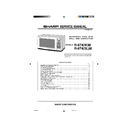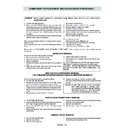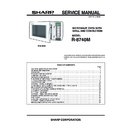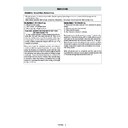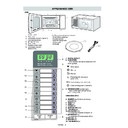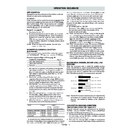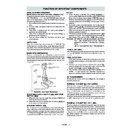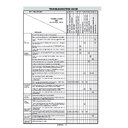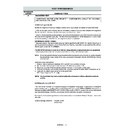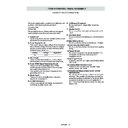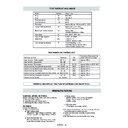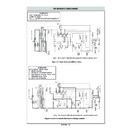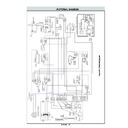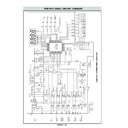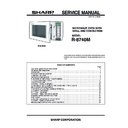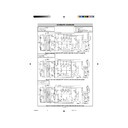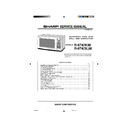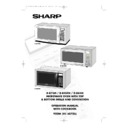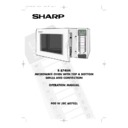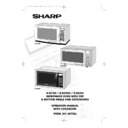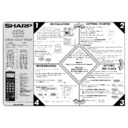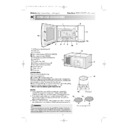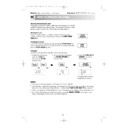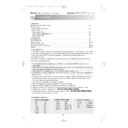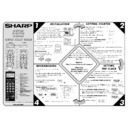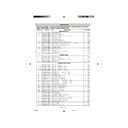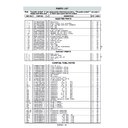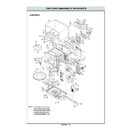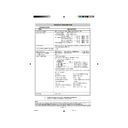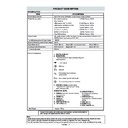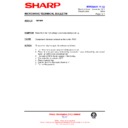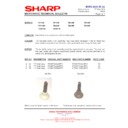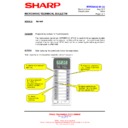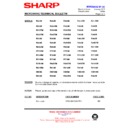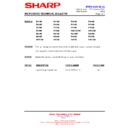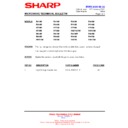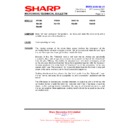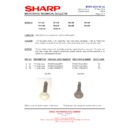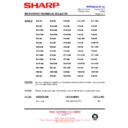Sharp R-874 (serv.man2) Service Manual ▷ View online
R-874M - 10
primary winding of the high voltage transformer.
6. The fuse F8A blows by the large electric currents.
7. The power supplying to the high voltage transformer is
7. The power supplying to the high voltage transformer is
cut off.
NOISE FILTER
The noise filter assembly prevents radio frequency inter-
ference that might flow back in the power circuit.
ference that might flow back in the power circuit.
TURNTABLE MOTOR
The turntable motor rotates the turntable.
FAN MOTOR
The fan motor drives a blade which draws external cool air.
This cool air is directed through the air vanes surrounding
the magnetron and cools the magnetron. This air is chan-
nelled through the oven cavity to remove steam and
vapours given off from heating food. It is then exhausted
through the exhausting air vents of the oven cavity.
This cool air is directed through the air vanes surrounding
the magnetron and cools the magnetron. This air is chan-
nelled through the oven cavity to remove steam and
vapours given off from heating food. It is then exhausted
through the exhausting air vents of the oven cavity.
CONVECTION MOTOR
The convection motor drives the convection fan and
provide the heated air.
provide the heated air.
TOP GRILL HEATING ELEMENT
The grill heating element is provided to brown the food and
is located on the top of the oven cavity.
is located on the top of the oven cavity.
BOTTOM GRILL HEATING ELEMENT
The grill heating element is provided to brown the food and
is located at the base of the oven cavity.
is located at the base of the oven cavity.
CONVECTION COOKING SYSTEM
Figure D-2. Convection Cooking System
FIRE SENSING FEATURE
The oven will stop its operation when there is a fire in the
oven cavity in microwave cooking condition.
LSI measures the voltage across the temperature meas-
urement circuit intermittently within 32-seconds time base
since the oven is started in microwave cooking condition.
The oven will stop its operation when the difference of the
voltage is more than 0.781 volts in microwave cooking
condition.
1. Within a 32-seconds base, the thermistor is energized
oven cavity in microwave cooking condition.
LSI measures the voltage across the temperature meas-
urement circuit intermittently within 32-seconds time base
since the oven is started in microwave cooking condition.
The oven will stop its operation when the difference of the
voltage is more than 0.781 volts in microwave cooking
condition.
1. Within a 32-seconds base, the thermistor is energized
for 2 seconds. At that time, the voltage across the
temperature measurement circuit is measured.
temperature measurement circuit is measured.
2. The oven carries out the procedure above again. If the
second voltage is 0.781V higher than first voltage, LSI
judges it is a fire in the oven cavity and stop the oven.
judges it is a fire in the oven cavity and stop the oven.
3. When LSI judges it is a fire in the oven cavity, LSI will
switch off the relays to high voltage transformer and fan
motor and LSI stops counting down.
motor and LSI stops counting down.
OPEN JUDGE BY THERMISTOR
1. If the temperature of the thermistor does not rise to
more than 40˚C after 4 minutes and 15 seconds from
when the oven is started in convection, grill (top and
bottom grills) or dual cooking mode, the oven is turned
off.
when the oven is started in convection, grill (top and
bottom grills) or dual cooking mode, the oven is turned
off.
2. When the thermistor or the wire harness to the thermis-
tor is opened, the oven is turned off after 4 minutes and
15 seconds because this condition is same as above.
15 seconds because this condition is same as above.
THERMISTOR
Sensing
Voltage
ON
OFF
ON
OFF
30
32 (sec.)
Sensing the voltage across temperature measurement circuit.
Door
Oven Cavity
Grill Heating
Element
Element
Bottom Grill
Heating Element
Heating Element
Convection
Passage
Passage
Cooling
Fan
Fan
Convection
Motor
Motor
Convection
Fan
Fan
Turntable
Insulation
Turntable
Motor
Motor
FUNCTION OF IMPORTANT COMPONENTS
TROUBLESHOOTING GUIDE
When troubleshooting the microwave oven, it is helpful to follow the Sequence of Operation in performing the checks.
Many of the possible causes of trouble will require that a specific test be performed. These tests are given a procedure
letter which will be found in the “Test Procedure” section.
Many of the possible causes of trouble will require that a specific test be performed. These tests are given a procedure
letter which will be found in the “Test Procedure” section.
IMPORTANT: If the oven becomes inoperative because of a blown fuse F8A in the monitored latch switch - monitor
switch circuit, check the monitored latch switch and monitor switch before replacing the fuse F8A.
R-874 S/MANUAL
11/7/01, 10:59 am
10
R-874M - 10
primary winding of the high voltage transformer.
6. The fuse F8A blows by the large electric currents.
7. The power supplying to the high voltage transformer is
7. The power supplying to the high voltage transformer is
cut off.
NOISE FILTER
The noise filter assembly prevents radio frequency inter-
ference that might flow back in the power circuit.
ference that might flow back in the power circuit.
TURNTABLE MOTOR
The turntable motor rotates the turntable.
FAN MOTOR
The fan motor drives a blade which draws external cool air.
This cool air is directed through the air vanes surrounding
the magnetron and cools the magnetron. This air is chan-
nelled through the oven cavity to remove steam and
vapours given off from heating food. It is then exhausted
through the exhausting air vents of the oven cavity.
This cool air is directed through the air vanes surrounding
the magnetron and cools the magnetron. This air is chan-
nelled through the oven cavity to remove steam and
vapours given off from heating food. It is then exhausted
through the exhausting air vents of the oven cavity.
CONVECTION MOTOR
The convection motor drives the convection fan and
provide the heated air.
provide the heated air.
TOP GRILL HEATING ELEMENT
The grill heating element is provided to brown the food and
is located on the top of the oven cavity.
is located on the top of the oven cavity.
BOTTOM GRILL HEATING ELEMENT
The grill heating element is provided to brown the food and
is located at the base of the oven cavity.
is located at the base of the oven cavity.
CONVECTION COOKING SYSTEM
Figure D-2. Convection Cooking System
FIRE SENSING FEATURE
The oven will stop its operation when there is a fire in the
oven cavity in microwave cooking condition.
LSI measures the voltage across the temperature meas-
urement circuit intermittently within 32-seconds time base
since the oven is started in microwave cooking condition.
The oven will stop its operation when the difference of the
voltage is more than 0.781 volts in microwave cooking
condition.
1. Within a 32-seconds base, the thermistor is energized
oven cavity in microwave cooking condition.
LSI measures the voltage across the temperature meas-
urement circuit intermittently within 32-seconds time base
since the oven is started in microwave cooking condition.
The oven will stop its operation when the difference of the
voltage is more than 0.781 volts in microwave cooking
condition.
1. Within a 32-seconds base, the thermistor is energized
for 2 seconds. At that time, the voltage across the
temperature measurement circuit is measured.
temperature measurement circuit is measured.
2. The oven carries out the procedure above again. If the
second voltage is 0.781V higher than first voltage, LSI
judges it is a fire in the oven cavity and stop the oven.
judges it is a fire in the oven cavity and stop the oven.
3. When LSI judges it is a fire in the oven cavity, LSI will
switch off the relays to high voltage transformer and fan
motor and LSI stops counting down.
motor and LSI stops counting down.
OPEN JUDGE BY THERMISTOR
1. If the temperature of the thermistor does not rise to
more than 40˚C after 4 minutes and 15 seconds from
when the oven is started in convection, grill (top and
bottom grills) or dual cooking mode, the oven is turned
off.
when the oven is started in convection, grill (top and
bottom grills) or dual cooking mode, the oven is turned
off.
2. When the thermistor or the wire harness to the thermis-
tor is opened, the oven is turned off after 4 minutes and
15 seconds because this condition is same as above.
15 seconds because this condition is same as above.
THERMISTOR
Sensing
Voltage
ON
OFF
ON
OFF
30
32 (sec.)
Sensing the voltage across temperature measurement circuit.
Door
Oven Cavity
Grill Heating
Element
Element
Bottom Grill
Heating Element
Heating Element
Convection
Passage
Passage
Cooling
Fan
Fan
Convection
Motor
Motor
Convection
Fan
Fan
Turntable
Insulation
Turntable
Motor
Motor
FUNCTION OF IMPORTANT COMPONENTS
TROUBLESHOOTING GUIDE
When troubleshooting the microwave oven, it is helpful to follow the Sequence of Operation in performing the checks.
Many of the possible causes of trouble will require that a specific test be performed. These tests are given a procedure
letter which will be found in the “Test Procedure” section.
Many of the possible causes of trouble will require that a specific test be performed. These tests are given a procedure
letter which will be found in the “Test Procedure” section.
IMPORTANT: If the oven becomes inoperative because of a blown fuse F8A in the monitored latch switch - monitor
switch circuit, check the monitored latch switch and monitor switch before replacing the fuse F8A.
R-874 S/MANUAL
11/7/01, 10:59 am
10
R-874M - 10
primary winding of the high voltage transformer.
6. The fuse F8A blows by the large electric currents.
7. The power supplying to the high voltage transformer is
7. The power supplying to the high voltage transformer is
cut off.
NOISE FILTER
The noise filter assembly prevents radio frequency inter-
ference that might flow back in the power circuit.
ference that might flow back in the power circuit.
TURNTABLE MOTOR
The turntable motor rotates the turntable.
FAN MOTOR
The fan motor drives a blade which draws external cool air.
This cool air is directed through the air vanes surrounding
the magnetron and cools the magnetron. This air is chan-
nelled through the oven cavity to remove steam and
vapours given off from heating food. It is then exhausted
through the exhausting air vents of the oven cavity.
This cool air is directed through the air vanes surrounding
the magnetron and cools the magnetron. This air is chan-
nelled through the oven cavity to remove steam and
vapours given off from heating food. It is then exhausted
through the exhausting air vents of the oven cavity.
CONVECTION MOTOR
The convection motor drives the convection fan and
provide the heated air.
provide the heated air.
TOP GRILL HEATING ELEMENT
The grill heating element is provided to brown the food and
is located on the top of the oven cavity.
is located on the top of the oven cavity.
BOTTOM GRILL HEATING ELEMENT
The grill heating element is provided to brown the food and
is located at the base of the oven cavity.
is located at the base of the oven cavity.
CONVECTION COOKING SYSTEM
Figure D-2. Convection Cooking System
FIRE SENSING FEATURE
The oven will stop its operation when there is a fire in the
oven cavity in microwave cooking condition.
LSI measures the voltage across the temperature meas-
urement circuit intermittently within 32-seconds time base
since the oven is started in microwave cooking condition.
The oven will stop its operation when the difference of the
voltage is more than 0.781 volts in microwave cooking
condition.
1. Within a 32-seconds base, the thermistor is energized
oven cavity in microwave cooking condition.
LSI measures the voltage across the temperature meas-
urement circuit intermittently within 32-seconds time base
since the oven is started in microwave cooking condition.
The oven will stop its operation when the difference of the
voltage is more than 0.781 volts in microwave cooking
condition.
1. Within a 32-seconds base, the thermistor is energized
for 2 seconds. At that time, the voltage across the
temperature measurement circuit is measured.
temperature measurement circuit is measured.
2. The oven carries out the procedure above again. If the
second voltage is 0.781V higher than first voltage, LSI
judges it is a fire in the oven cavity and stop the oven.
judges it is a fire in the oven cavity and stop the oven.
3. When LSI judges it is a fire in the oven cavity, LSI will
switch off the relays to high voltage transformer and fan
motor and LSI stops counting down.
motor and LSI stops counting down.
OPEN JUDGE BY THERMISTOR
1. If the temperature of the thermistor does not rise to
more than 40˚C after 4 minutes and 15 seconds from
when the oven is started in convection, grill (top and
bottom grills) or dual cooking mode, the oven is turned
off.
when the oven is started in convection, grill (top and
bottom grills) or dual cooking mode, the oven is turned
off.
2. When the thermistor or the wire harness to the thermis-
tor is opened, the oven is turned off after 4 minutes and
15 seconds because this condition is same as above.
15 seconds because this condition is same as above.
THERMISTOR
Sensing
Voltage
ON
OFF
ON
OFF
30
32 (sec.)
Sensing the voltage across temperature measurement circuit.
Door
Oven Cavity
Grill Heating
Element
Element
Bottom Grill
Heating Element
Heating Element
Convection
Passage
Passage
Cooling
Fan
Fan
Convection
Motor
Motor
Convection
Fan
Fan
Turntable
Insulation
Turntable
Motor
Motor
FUNCTION OF IMPORTANT COMPONENTS
TROUBLESHOOTING GUIDE
When troubleshooting the microwave oven, it is helpful to follow the Sequence of Operation in performing the checks.
Many of the possible causes of trouble will require that a specific test be performed. These tests are given a procedure
letter which will be found in the “Test Procedure” section.
Many of the possible causes of trouble will require that a specific test be performed. These tests are given a procedure
letter which will be found in the “Test Procedure” section.
IMPORTANT: If the oven becomes inoperative because of a blown fuse F8A in the monitored latch switch - monitor
switch circuit, check the monitored latch switch and monitor switch before replacing the fuse F8A.
R-874 S/MANUAL
11/7/01, 10:59 am
10
R-874M - 10
primary winding of the high voltage transformer.
6. The fuse F8A blows by the large electric currents.
7. The power supplying to the high voltage transformer is
7. The power supplying to the high voltage transformer is
cut off.
NOISE FILTER
The noise filter assembly prevents radio frequency inter-
ference that might flow back in the power circuit.
ference that might flow back in the power circuit.
TURNTABLE MOTOR
The turntable motor rotates the turntable.
FAN MOTOR
The fan motor drives a blade which draws external cool air.
This cool air is directed through the air vanes surrounding
the magnetron and cools the magnetron. This air is chan-
nelled through the oven cavity to remove steam and
vapours given off from heating food. It is then exhausted
through the exhausting air vents of the oven cavity.
This cool air is directed through the air vanes surrounding
the magnetron and cools the magnetron. This air is chan-
nelled through the oven cavity to remove steam and
vapours given off from heating food. It is then exhausted
through the exhausting air vents of the oven cavity.
CONVECTION MOTOR
The convection motor drives the convection fan and
provide the heated air.
provide the heated air.
TOP GRILL HEATING ELEMENT
The grill heating element is provided to brown the food and
is located on the top of the oven cavity.
is located on the top of the oven cavity.
BOTTOM GRILL HEATING ELEMENT
The grill heating element is provided to brown the food and
is located at the base of the oven cavity.
is located at the base of the oven cavity.
CONVECTION COOKING SYSTEM
Figure D-2. Convection Cooking System
FIRE SENSING FEATURE
The oven will stop its operation when there is a fire in the
oven cavity in microwave cooking condition.
LSI measures the voltage across the temperature meas-
urement circuit intermittently within 32-seconds time base
since the oven is started in microwave cooking condition.
The oven will stop its operation when the difference of the
voltage is more than 0.781 volts in microwave cooking
condition.
1. Within a 32-seconds base, the thermistor is energized
oven cavity in microwave cooking condition.
LSI measures the voltage across the temperature meas-
urement circuit intermittently within 32-seconds time base
since the oven is started in microwave cooking condition.
The oven will stop its operation when the difference of the
voltage is more than 0.781 volts in microwave cooking
condition.
1. Within a 32-seconds base, the thermistor is energized
for 2 seconds. At that time, the voltage across the
temperature measurement circuit is measured.
temperature measurement circuit is measured.
2. The oven carries out the procedure above again. If the
second voltage is 0.781V higher than first voltage, LSI
judges it is a fire in the oven cavity and stop the oven.
judges it is a fire in the oven cavity and stop the oven.
3. When LSI judges it is a fire in the oven cavity, LSI will
switch off the relays to high voltage transformer and fan
motor and LSI stops counting down.
motor and LSI stops counting down.
OPEN JUDGE BY THERMISTOR
1. If the temperature of the thermistor does not rise to
more than 40˚C after 4 minutes and 15 seconds from
when the oven is started in convection, grill (top and
bottom grills) or dual cooking mode, the oven is turned
off.
when the oven is started in convection, grill (top and
bottom grills) or dual cooking mode, the oven is turned
off.
2. When the thermistor or the wire harness to the thermis-
tor is opened, the oven is turned off after 4 minutes and
15 seconds because this condition is same as above.
15 seconds because this condition is same as above.
THERMISTOR
Sensing
Voltage
ON
OFF
ON
OFF
30
32 (sec.)
Sensing the voltage across temperature measurement circuit.
Door
Oven Cavity
Grill Heating
Element
Element
Bottom Grill
Heating Element
Heating Element
Convection
Passage
Passage
Cooling
Fan
Fan
Convection
Motor
Motor
Convection
Fan
Fan
Turntable
Insulation
Turntable
Motor
Motor
FUNCTION OF IMPORTANT COMPONENTS
TROUBLESHOOTING GUIDE
When troubleshooting the microwave oven, it is helpful to follow the Sequence of Operation in performing the checks.
Many of the possible causes of trouble will require that a specific test be performed. These tests are given a procedure
letter which will be found in the “Test Procedure” section.
Many of the possible causes of trouble will require that a specific test be performed. These tests are given a procedure
letter which will be found in the “Test Procedure” section.
IMPORTANT: If the oven becomes inoperative because of a blown fuse F8A in the monitored latch switch - monitor
switch circuit, check the monitored latch switch and monitor switch before replacing the fuse F8A.
R-874 S/MANUAL
11/7/01, 10:59 am
10

